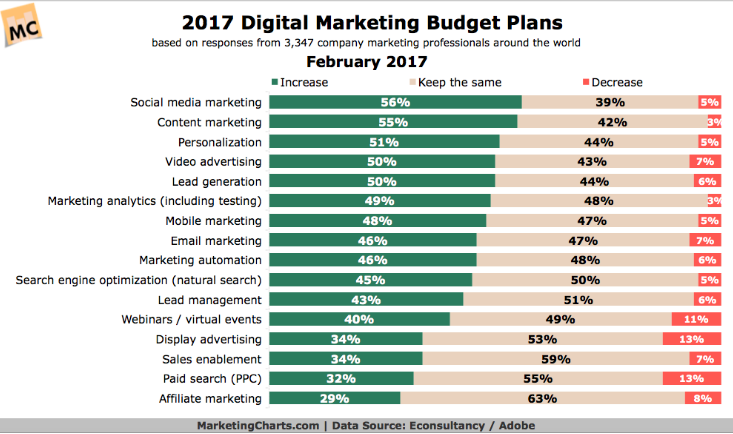How to Develop a Small Business Marketing Budget

Yes, I’m going there. I’ll be answering one of the most dreaded questions of all times: “How the heck do I create a small business marketing budget?”
I’ve been tasked with this more than once and, trust me, it was never easy.
You see, there is no typical budget for startup or for an established small business. There is no template that you can fill in with your data and call it a day.
Everything is different from company to company.
Which is the first reason why it’s hard to create a small business marketing budget. Here’s the second one:
Creating a Small Business Marketing Budget Is, Perhaps, the Most Important Thing in Your Plan
For what is a marketing plan without a budget to sustain it?
A dream, that’s what it is.
Whenever we onboard new clients at Idunn, I ask about their budget. Whether they are looking for copywriting services or marketing strategy, their answer is almost always “not sure” or “I don’t know”.
I understand when people are looking for suggestions – after all, we’ve already established that small business marketing budget planning is a murky business. But you have to have some idea about what you’re willing to spend.
Something else I’ve noticed is that people think about the money they have available to invest in various marketing activities instead of what they need to invest.
And no, I’m not saying you should go rob a bank if you don’t have the marketing budget you need. I’m just saying that there are better ways to determine your budget other than looking at your bank statement and trying to calculate what’s left at the end of the month.
Let’s take a look at some of these ways.
How to Design a Small Business Marketing Plan that’s both Effective and Realistic
Some studies suggest that 62% of SMBs invest 4% of their revenue or more in marketing. In other words, if you have a monthly revenue of $10,000, $400 of it should go towards marketing activities.
I know, it’s not a lot, but it’s a start.
However, establishing your small business marketing budget as a percentage of your revenue may not be ideal for everyone. As I said: there is no one-size-fits-all in marketing budgeting.
For instance a solopreneur who earns $10,000 may not have a lot of other expenses and can afford to spend much more than 4% to ensure the growth of their business. On the other hand, a company with a much larger revenue may not be able to spare 4% (out of, say, $500,000 per month) because of their operational expenses (think about the expenses of a high-end beauty clinic, for instance). Still, even if they spend 1% on marketing, they can make a significant difference.
So how should you set your marketing budget?
Here are some places to start:
-
Consider Your Business Goals
After all, your entire marketing plan should be designed to support them. Forget about vanity metrics and think about business growth.
Your goals should meet a few criteria.
 Image via Appleby Mall
Image via Appleby Mall
Let’s take a look at all of them.
Being specific means that you should think numbers rather than unquantifiable goals. For example,
“I want my business to grow”
or
“I want more clients”
Aren’t specific goals. What do they mean and how could you possibly create a marketing budget and a plan for them?
On the other hand:
“I want my business to grow by 20% year-over-year”
or
“I want to acquire 10 premium clients per month”
Are specific, measurable and timely. However, it’s up to you to decide whether they are also realistic and achievable.
Setting goals like these won’t just help you create your small business marketing budget. It will also help you choose the digital marketing channels that will help you grow your business.
Speaking of which:
-
Think about the Channels You Want to Use
Go back to your buyer persona. Where do they hang out? Are they Facebook people or Instagram ones? Do they hate emails or do they live in their inbox? What other services and products are they fans of or use on a daily basis?
When you have all these questions answered, you should be able to shortlist a few digital marketing channels that are most suitable to speak to your audience.
Why not choose all of them?
Well, you could if you had an unlimited marketing budget.
But, as you know, every channel comes with a different price tag and with a different timeline for effectiveness.
For instance, if you were to outsource content writing, you can’t expect results the very next day. However, when they do appear they would be longer-lasting than those of AdWords or other form of PPC ads.
After all, there is a reason why the prices of copywriting services are increasing continuously. Copywriting and content writing WORK.
Thus, if you need to acquire clients quickly, then PPC ads or perhaps even outsourcing your social media marketing are the way to go.
If, on the other hand, you want your small business marketing budget to produce long-term results, you should consider content writing, SEO copywriters and inbound sales.
Consider your short and long-term strategy carefully – getting new clients right now may look appealing, but keep in mind that as soon as your ads budget is depleted, so is your source for lead generation.
Ideally, you should be dividing your marketing budget between the two. This way, you can ensure a steady revenue stream right now and have a good start for tactics that produce excellent results in time.
A final caveat here: while it may be tempting to test everything before you commit, make sure you don’t spread yourself too thin. Most marketing tactics become ineffective if you don’t allocate enough time and enough human and financial resources to them.
This chart is a good place to start. Take a look at how the average company is splitting their marketing budget between channels. Still, bear in mind that this is by no means to be taken as a definitive guide. The numbers vary greatly according to industry, competition to beat, company size and more.
 Image via WebStrategies
Image via WebStrategies
-
Consider Your Operational Costs
The rule of thumb dictates that you should invest 10% of your revenue in marketing. Again, much like the studies that found the average company to invest 4% of their revenue in marketing, this is not to be taken as an absolute.
Your small business marketing budget is but your own.
Consequently, it should only reflect your own needs and your own view of success.
More importantly, it needs to take into account your own operational costs.
You may be willing to invest as much as 50% of your revenue in marketing, but you also have to pay your employees, your rent, your utility bills and the software you use to keep your business afloat.
However, there is another metric you can use to come up with your very own ideal small business marketing budget: your projected profit.
For example, if your revenue is $10 this month, taking into account your operational costs, as well as other costs you may incur, you will be left with a projected profit of $4.
How much of that are you willing to spend on marketing? Given that we are referring to profit, it can be as much as (or even more than) 50%.
I have found this approach to be very useful for Idunn. But that may be just me. By using this approach, I can make sure that I never spend too much (or too little) on marketing and that, at the end of the month, we can comfortably pay our writers, social media experts, accountant, as well as all the other bills.
-
Be Prepared for Unforeseen Marketing Expenses
If there’s something certain in the world of marketing it’s this: nothing is certain.
Facebook changed its algorithm yet again to push businesses to invest more in ads. Google also changes its algorithm quite frequently, with a direct impact on your SEO.
On top of that, new social media networks and new trends appear and rise every day. Of course, you are not supposed to try them all. Quite the opposite.
But you should be prepared in case that perfect fit for your company appears.
Thus, when you create your small business marketing budget, make sure to include a category for unforeseen expenses.
Aside from new shiny things you could try, you also need to account for things like having to replace one or two members of your team or agency, price increases and more.
Finally, a rule of thumb borrowed from growth hacking will help you be in control of your budget at all times: “if it doesn’t help me grow, I won’t do it.”
When you choose the places to spend your marketing budget, ask yourself if they will bring you new clients/extra revenue. If not, move on.
Wrapping Things Up
Lastly, if you want to keep things well under control, I strongly suggest you use a template that’s easy to customize and modify as you go. HubSpot has quite a few nice ones and they’re completely free to download.
Whatever method you use to determine your small business marketing budget, keep in mind that one thing is more important than all others: the way you spend it. Choosing the right channels and the right people to implement your tactics is the only way to ensure the ROI you need.
Still confused about how to develop a small business marketing budget? We can help! Our skilled marketers have helped dozens of small and medium businesses make the most out of their marketing budgets.
Let’s talk and make sure your marketing dollars are put to good use:


1 Comentariu la “How to Develop a Small Business Marketing Budget”
[…] a small business marketing budget is no easy task. Just look at the options above. How could you possibly be sure that you chose […]